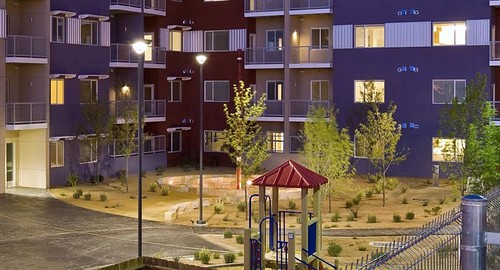The proof is in: smart growth reduces risk of mortgage default

Posted June 27, 2013 at 1:40PM
An exhaustive analysis of 37,000 mortgages on multifamily rental properties has found that, when other factors are appropriately controlled, those properties in smart locations are substantially less likely to incur default on payments than those in average locations. Specific locational factors found to reduce the risk of default include reduced commute time, use of rail transit, walkability, the presence of retail uses, the integration of affordable housing, and proximity to parks and open space. Proximity to a freeway was found to increase the risk of default, as was increased commute time.
The research was performed by Gary Pivo of the University of Arizona and supported and published by Fannie Mae. An excellent synopsis was published earlier this month by Laurence Aurbach in his blog PedShed.
The numbers are quite impressive:
- Close-in locations matter. Every additional minute of commute time raises the risk of default 3.7 percent. (Put another way, every five minutes of additional commute time raises the risk 18.5 percent.)
- Transit matters. If 30 percent or more workers in a location commute by rail transit, the risk of default is reduced by 58.4 percent.
- Walkability matters. Every one percent increase in the share of workers who walk to work decreases the risk of default by 3.1 percent.
- Mixed uses matter. If there are 16 or more retail establishments nearby, the risk of default is reduced by 34.4 percent.
- Affordability matters. If the multifamily building qualifies as affordable housing under Fannie Mae criteria, the risk of default is reduced by 61.9 percent.
- Parks matter. If the property is located within one mile of protected green space, the risk of default is reduced by 32.5 percent.
- Distance from freeways matters. If the property is located within 1000 feet of a freeway corridor, the risk of default goes up 59 percent.
Pivo examined Fannie Mae’s database of loans to owners of multifamily rental properties, so his study was a look at “wholesale” patterns of default, not a “retail” examination of individual homes. But we already had significant evidence that individual owners are less likely to default in inner, urban locations than in outer, suburban ones. We already had strong evidence that property values of individual homes have proven more resilient in inner, urban locations well-served by transit than in outer, suburban ones that are automobile-dependent. Pivo’s new examination shows that urban markets are stronger for multifamily rental properties as well and bases the finding on a particularly strong mortgage database.
In the new study, the total number of defaults was small when compared to the total number of loans (less than one percent), but the massive size of the database was still able to produce sufficient numbers to produce telling results with regard to the geography of the loans that were and were not in default. The average age of the loans was six years, though many reflected refinancing of mortgages on older properties.
In the early 1990s my NRDC colleague David Goldstein hypothesized that buyers of homes in urban areas would have lower transportation costs and thus more income to spend on mortgages than would buyers in suburban, automobile-dependent locations. David and NRDC hired transportation researcher John Holtzclaw to look into the issue and found strong evidence that the hypothesis was correct. Since then the issue has been much more thoroughly examined and refined by a number of researchers, most notably by the Center for Neighborhood Technology and its amazing Housing + Transportation Affordability Index.
CNT’s online tool can take almost any address in a metropolitan area and tell you how much people spend in its neighborhood, on average, for both housing and transportation. (The website will also give details on driving and carbon emission rates.) People who live in urban, “location-efficient” neighborhoods save money on transportation by driving less and owning fewer vehicles than people the same metro regions taken as a whole.
CNT, David, and their partners have long believed that taking locational factors into account would strengthen mortgage lending decisions. Pivo’s research demonstrates it, albeit by looking at factors other than driving rates. The full study can be downloaded here.
Related posts:
- New DC data confirm real estate recovery strongest in central & transit-served locations (March 26, 2013)
- How the evolving housing market will help sustainable communities (April 4, 2012)
- Geography of housing recovery favors cities and walkable neighborhoods (October 26, 2011)
- Most important analysis of land use you'll see all year: CNT proves benefits of smart growth nationwide (March 24, 2010)
- The geography of foreclosures, home values continues to expose sprawl (October 28, 2008)
Move your cursor over the images for credit information.
Please also visit NRDC’s sustainable communities video channels.
